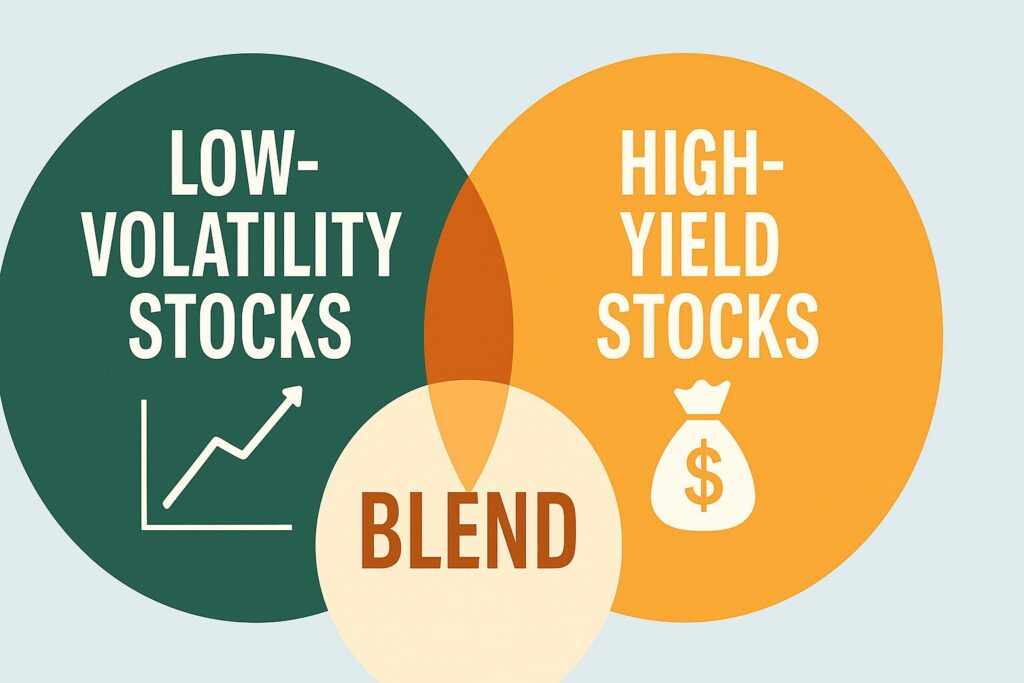
A Strategy for Stable Income and Smoother Growth for Retirees
For retirees, investing isn’t about chasing the next big thing—it’s about preserving what you have, earning steady income, and sleeping well at night. But many seniors still want some growth, too.
That’s where a blended strategy of low-volatility and high-yield stocks can shine.
This post explores how combining these two investment styles can create a smoother ride for your portfolio while still generating the income you need.
🌱 Why Retirees Need a Smoother Investment Experience
Traditional stock investing can be stressful—especially in retirement. Large swings in value can cause emotional decisions, panic selling, or even real financial harm if you’re forced to withdraw when the market is down.
That’s why many retirees look for:
- Lower volatility: Stocks that don’t swing wildly
- Higher income: Stocks that provide regular dividend checks
- Reliable growth: Investments that offer modest long-term appreciation
The goal isn’t just to survive retirement—it’s to thrive in it, without watching your account balance like a hawk.
📉 What Are Low-Volatility Stocks?
Low-volatility stocks are companies that tend to hold up better during market downturns. They may not shoot up during bull markets, but they don’t crash hard in bear markets either.
Common traits include:
- Consistent earnings
- Large customer bases
- Stable business models
- Strong dividends
These are often found in defensive sectors like:
- Utilities
- Consumer staples (like food, soap, and toothpaste)
- Healthcare
🧩 Think: Johnson & Johnson, Procter & Gamble, Coca-Cola, and Duke Energy.
You can invest in these stocks individually or through ETFs like:
- USMV – iShares MSCI Minimum Volatility ETF
- SPLV – Invesco S&P 500 Low Volatility ETF
💸 What Are High-Yield Stocks?
High-yield stocks provide a generous dividend—typically 4% or more annually. These dividends can be reinvested or used to supplement retirement income.
High yield doesn’t always mean high risk, but caution is needed:
- Sustainable payouts matter more than size.
- Look for companies with stable cash flow, not just a big headline yield.
Common sources of high-yield stocks:
- Real Estate Investment Trusts (REITs)
- Master Limited Partnerships (MLPs)
- Utilities and infrastructure firms
- Business Development Companies (BDCs)
Examples of high-yield ETFs include:
- VYM – Vanguard High Dividend Yield ETF
- SCHD – Schwab U.S. Dividend Equity ETF
- DIV – Global X SuperDividend ETF
🔄 Why Combine Low-Volatility and High-Yield?
Separately, each strategy offers strengths:
| Strategy | Strengths | Weaknesses |
|---|---|---|
| Low-volatility | Reduces market swings, good for stability | May offer lower income |
| High-yield | Provides dependable income | Can be riskier if companies overpay |
But together, they can balance each other out.
✅ Low-volatility stocks cushion market drops
✅ High-yield stocks produce consistent income
✅ Combined, you get a defensive yet rewarding portfolio
🧠 A Real-Life Example
George, a 68-year-old retiree, wanted to earn income from his portfolio but hated watching the market bounce up and down.
Here’s how he built his “boring but beautiful” portfolio:
- 40% in low-volatility ETFs (USMV and SPLV)
- 40% in dividend ETFs (SCHD and VYM)
- 20% in short-term bonds and cash for stability
This mix gave him:
- Dividend income of about 4.5% annually
- Smoother returns during downturns
- Peace of mind in volatile markets
He reinvests dividends for now, with the option to start drawing income later. As George says, “I’m not trying to beat the market—I’m just trying to not get beat.”
📊 Sample Portfolio for Retirees
Here’s an example of how you might blend low-volatility and high-yield in a 60/40 income-focused portfolio:
Stock Allocation (60%)
- 30% Low-volatility ETF (like SPLV or USMV)
- 30% High-dividend ETF (like SCHD or VYM)
Bond/Cash Allocation (40%)
- 25% Short-term bond ETF or ladder
- 15% Cash or money market for near-term spending
Bonus tip: Rebalance once a year to stay on track and manage risk.
⚠️ What to Watch Out For
While this strategy is relatively conservative, here are a few things to keep in mind:
- Chasing yield can be dangerous. Make sure dividends are backed by earnings.
- Diversification is key. Don’t overload on one sector (like energy or REITs).
- Dividends aren’t guaranteed. Even reliable companies can cut payouts in a crisis.
- Review regularly. Even boring portfolios need occasional checkups.
🔐 The Benefits of a Blended Approach
By combining low-volatility and high-yield investments, you get the best of both worlds:
1. More predictable income
Dividends come in like clockwork, month after month or quarter after quarter.
2. Smoother ride
Lower volatility helps reduce the emotional roller-coaster of market crashes.
3. Flexible use of dividends
Reinvest for growth in early retirement; spend them for income later on.
4. Easier to stick with
Portfolios that don’t scare you are portfolios you’re more likely to keep.
📝 Final Thoughts
Retirement investing doesn’t have to be all-or-nothing. You don’t need to swing for the fences or hide everything under a mattress. A thoughtful blend of low-volatility and high-yield stocks offers a stable middle ground—a “sleep well at night” approach that still gives you real returns.
It’s not flashy. It’s not fancy. But it works. And for retirees, that may be exactly what you need.
📘 This post is adapted from my book:
Your Boring Portfolio: Getting Off the Stock Market Roller-Coaster and Sleep Well At Night With Low-Volatility Stocks
Available now at Amazon.com in paperback and eBook formats.
Disclaimer: This article is for informational purposes only and does not constitute financial, investment, or tax advice. Consult a licensed financial professional before making investment decisions. Past performance is not indicative of future results.